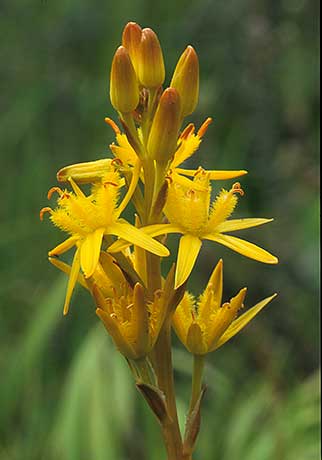Bog asphodel (Narthecium ossifragum)
When: July - ugust
How many:
Widespread and often abundant

Bog asphodel’s cheery, bright yellow mid-summer pyramidal flower spikes bring alive many New Forest mires. Common and widespread in this favoured habitat, bog asphodels are readily noticeable, erect plants that grow to a height of 40 centimetres (16 inches), although they are usually somewhat shorter.
Prominent, woolly, orange-tipped stamens set off the showy yellow bog asphodel petals, whilst after flowering much of the bog asphodel assumes a deep orange colour. Reddish-orange egg-shaped fruits remain visible right the way through the autumn, whilst within, tiny seeds have a tail at either end that helps them float in times of flooding.
Long, slender sword-shaped leaves grow from the base of bog asphodels, whilst thick, underground stems thrive in loose, wet soil, sending out shoots to start new life afresh, adding to the often crowded bog asphodel spectacle.
In days gone by, bog asphodels were used as a blond dye for cloth and hair, which led to the local name ‘maiden’s hair’. In parts of Yorkshire, though, bog asphodels were most appropriately known as ‘moor-golds’, whilst in the New Forest, John Wise in his mid-19th century book refers to Lancashire Bog Asphodel, a name recalling the high north-west bogs and moors that to this day remain a major stronghold for this attractive plant.
Bog asphodel once had a reputation when eaten for weakening the bones of cattle, poisoning sheep and causing stiffness in animal joints – the ossifragum part of the Latin name refers to bone-breaking. These beliefs have, however, been disproved, much to the relief of New Forest commoners whose stock stalk the bogs, eating just about anything edible that takes their fancy.
References:
Reader’s Digest Field Guide to the Wild Flowers of Britain
The Encyclopedia of British Wild Flowers: John Akeroyd
The Englishman’s Flora: Geoffrey Grigson
The New Forest: Its History and Scenery: John R. Wise
More links
Other related links
Search this site

Sadly, 58 animals were killed - 35 ponies, 13 cows, 8 donkeys and 2 sheep, whilst a further 32 were injured - 3 pigs, 9 donkeys, 11 cows and 9 ponies.
(Forty-three accidents occurred in daylight, 15 at twilight and 101 in the dark. Twenty-seven accidents were not reported by the driver involved).
Here's just one horrific example - Three donkeys killed in collision with van at notorious New Forest blackspot (Advertiser and Times)

